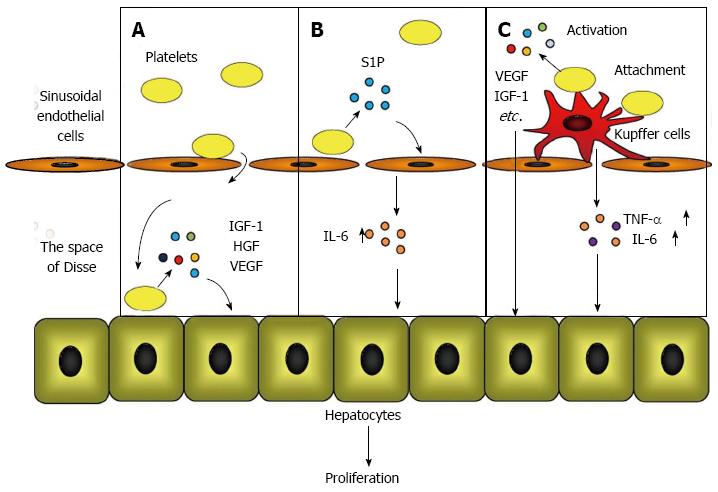Copyright
©2013 Baishideng Publishing Group Co.
World J Surg Proced. Nov 28, 2013; 3(3): 29-36
Published online Nov 28, 2013. doi: 10.5412/wjsp.v3.i3.29
Published online Nov 28, 2013. doi: 10.5412/wjsp.v3.i3.29
Figure 1 Platelet-mediated liver regeneration.
Platelets accumulate in the liver immediately after a hepatectomy. A: Platelets translocate into the space of Disse and release insulin-like growth factor (IGF)-1, hepatocyte growth factor (HGF), and vascular endothelial growth factor (VEGF) by directly contacting hepatocytes; B: Direct contact of platelets with liver sinusoidal endothelial cells induces the release of S1P from platelets and the secretion of interleukin-6 (IL-6) from liver sinusoidal endothelial cells; C: Kupffer cells activated in response to a hepatectomy induce the accumulation and activation of platelets. Growth factors released from platelets and the enhanced release of tumor necrosis factor-α (TNF-α) and IL-6 from Kupffer cells promote liver regeneration.
- Citation: Takahashi K, Murata S, Ohkohchi N. Platelet therapy: A novel strategy for liver regeneration, anti-fibrosis, and anti-apoptosis. World J Surg Proced 2013; 3(3): 29-36
- URL: https://www.wjgnet.com/2219-2832/full/v3/i3/29.htm
- DOI: https://dx.doi.org/10.5412/wjsp.v3.i3.29









